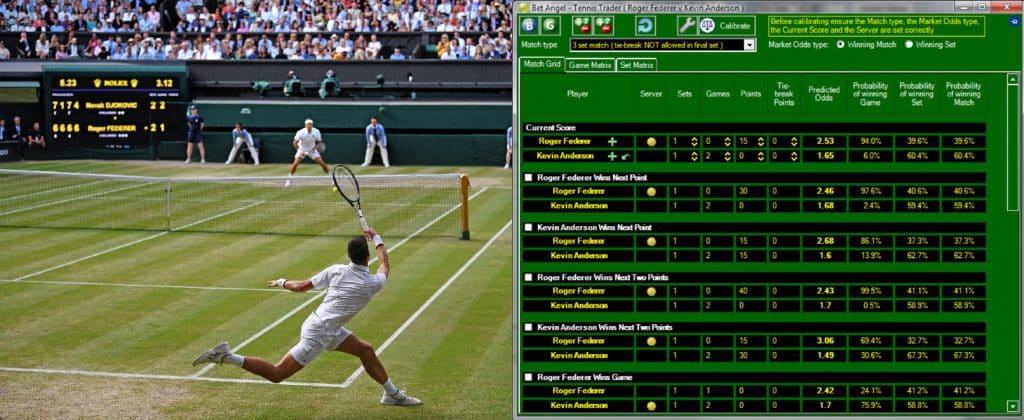Tennis betting tips might look simple on the surface, but bookmakers hide significant information from their customers. Tennis ranks among the world’s most popular betting sports. Bettors flock to weekly ATP and WTA Tour events, especially when it comes to the four major Grand Slams, where winners take home 2000 ranking points.
OLBG’s team of tennis tipsters has grown remarkably in the last 20+ years. We provide free tennis predictions for all major events. Our experts consistently deliver tennis bet tips with high strike rates and monthly profits. The community shares tennis tips today that cover everything from the Australian Open to regular tour matches. We know what bookmakers don’t tell you about tennis betting. Players tend to shine or struggle at specific tournaments. Some players become specialists on certain surfaces.
This piece reveals seven secrets bookmakers keep from tennis bettors and helps you find value bets. You’ll learn to spot opportunities others miss by analysing thousands of scenarios and understanding what makes tennis predictions work. Our tipster competition awards 33 monthly prizes worth £235 – proof of the quality advice you’ll discover here.
The most common tennis bets and how they work
Tennis betting markets can give you a substantial advantage when you understand how they work. Bookmakers provide several common bet types, and each comes with its own quirks and opportunities for value.
Match winner bets
Match winner bets are the most popular and simple tennis wager. You just need to pick which player will win the match outright—no other criteria matter. These bets show up as moneylines where favourites have negative numbers and underdogs have positive values. You’d need to bet £146.92 on Djokovic at -185 to win £79.42, while £79.42 on Federer at +165 would return £131.04 if he wins.
Match winner bets are the foundations of tennis betting. They rarely offer good value when you back heavy favourites. Top players like Iga Świątek might be priced at -600 against qualifiers in early tournament rounds. These bets are “safe” but need large stakes to make modest returns.
Set score predictions
Set score predictions let you bet on the exact scoreline in sets, offering better payouts than match winner odds. Rather than just backing “Nadal to Win,” you pick “Nadal to Win 3-0” in a best-of-five match. The odds are higher because these bets are more specific.
Best-of-three matches give you these options:
- Player A wins 2-0
- Player A wins 2-1
- Player B wins 2-0
- Player B wins 2-1
This market works great when you think a favourite will cruise to victory, giving better value than the simple moneyline. The bets can also pay well when you spot players who start slowly but bounce back.
Over/under total games
Over/under bets look at the total games played in a match, whatever the outcome. Bookmakers pick a line—usually around 20.5 or 22.5 games—and you predict if the match will have more or fewer games than that number.
Professional tennis averages about nine games per set. This number helps bookmakers set their game total lines. A line at 20.5 games in a best-of-three match means betting “over” usually assumes the match will go to a third set.
Take a Tiafoe vs Sinner match with a 22.5 game line:
- A 7-6, 6-4 result gives 23 games—an “over” win
- A 6-4, 6-4 result gives 20 games—an “under” win
Smart bettors love this market during in-play betting. They watch how the match unfolds and time their bets perfectly.
Handicap betting explained
Handicap betting creates a level playing field between mismatched competitors by adding virtual advantages or disadvantages. This leads to balanced odds in matches with clear favourites.
Game handicaps give the favourite a negative number (like -4.5 games) and the underdog a positive one (like +4.5 games). Murray (-4.5) beating De Schepper 6-2, 6-2 means a total of 12-4 games. After the handicap: 12-4.5=7.5, making Murray’s handicap bet a winner.
Set handicaps work differently. They count sets won, not games played. A -1.5 set handicap means a player must win in straight sets (2-0 in best-of-three) to win the bet.
These markets help you find value beyond simple match odds. They work especially well when backing strong favourites or using player patterns that bookmakers might have missed in their odds.

7 tennis betting tips bookmakers don’t want you to know
Bookmakers thrive on bettors who lack knowledge. My years of analysing tennis markets have revealed several insider secrets that can improve your winning chances by a lot. Here are seven tennis betting tips bookmakers hope you never discover.
1. Odds don’t reflect true probabilities
The odds you see aren’t just mathematical calculations of a player’s chances. Bookmakers build in a profit margin (known as the “vig” or “juice”) of typically 5-7% in tennis markets. This margin ensures you’ll lose money mathematically if you pick winners randomly over time. I always convert odds to implied probabilities and search for cases where the bookmaker’s assessment is different from my analysis.
2. Bookmakers adjust lines based on public bias
Popular tennis players attract heavy betting action regardless of their actual form. Novak Djokovic, Rafael Nadal, and Serena Williams get substantial public backing. The bookmakers shade their lines and offer worse odds on these players than their true chances deserve. This creates value opportunities for their opponents, especially when a star player returns from injury or shows signs that casual fans miss.
3. Promotions are designed to lock you in
Welcome bonuses and free bets aren’t as generous as they seem. You’ll need to bet the bonus amount several times before you can withdraw winnings. These rules keep you betting longer, so you’re more likely to lose your initial deposit and bonus. Smart bettors focus on finding genuine market value instead of chasing promotions.
4. In-play betting is where most bettors lose
Live betting creates an adrenaline rush that clouds judgment. Bookmakers know this psychology well and adjust their in-play margins to 10% or higher during matches. Recreational bettors make snap decisions while watching matches. Bookmakers use sophisticated algorithms that work faster than humans can react. You should approach in-play markets carefully unless you have a specific edge, like being at matches to spot player injuries before odds change.
5. Bookies track your betting behaviour
Bookmakers will limit your stakes or restrict your account once you show consistent winning patterns. Their tracking systems flag successful bettors who grab the best odds before they shorten. You can spread your bets across multiple bookmakers to avoid detection. Note that they look for methodical winners rather than lucky ones.
6. Cash-out is rarely in your favour
The cash-out option looks convenient, but it works against you mathematically. Bookmakers add an extra margin beyond their standard one for early cash-outs. They offer these options at moments when you’re most likely to accept out of fear. The best approach is to develop clear pre-match criteria for hedging positions and stick to your plan.
7. Value bets are often hidden in lower-tier matches
ATP and WTA Challenger events get much less betting attention than Grand Slams. Bookmakers don’t know these players and conditions as well. This information asymmetry creates opportunities for bettors who follow these circuits closely. The best value lies in matches played under unusual conditions – extreme heat, altitude, or unique court surfaces, where specialised knowledge beats general market assessment.
Understanding how tennis betting markets work helps you make smarter decisions that overcome bookmakers’ advantages. Success comes from developing specialised knowledge and maintaining disciplined betting practices that value smart plays over entertainment.
How to spot value in tennis predictions
“Account for surface types and the context of stats” — SportyTrader, Leading sports betting analysis platform
Value betting is the lifeblood of profitable tennis wagering. You need to know where true betting opportunities exist to beat the bookmakers consistently.
Understanding implied probability
Implied probability shows how likely an outcome is based on bookmaker odds. A simple formula calculates this from decimal odds: Implied Probability (%) = 100 / Decimal Odds. This percentage has the bookmaker’s profit margin, or “vig,” built in.
Let’s look at a real example: Carlos Alcaraz priced at 2.40 to win a match would have 41.67% (100 ÷ 2.40) implied probability. Your research might suggest he has a 50% chance of winning, which means you’ve found a value bet.
American odds need different calculations:
- Negative odds: odds / (odds + 100) × 100 = implied probability
- Positive odds: 100 / (odds + 100) × 100 = implied probability
Value exists any time your estimated probability is higher than the bookmaker’s implied probability.
Comparing odds across bookmakers
“Line shopping” remains one of the most overlooked yet effective ways to bet on tennis. A mere 5% difference in odds can significantly boost your long-term results. To name just one example, finding Stefanos Tsitsipas at 2.55 instead of 2.40 on another site means better returns over hundreds of bets.
Oddschecker, Oddspedia, and Oddsportal help you compare tennis betting odds across many bookmakers at once. Professional bettors stress the importance of using at least five bookmakers to maximise your edge.
You’ll also benefit by spreading your bets across multiple platforms, which delays potential account restrictions often targeting winning players.
Using historical player data
Tennis predictions need more than simple win/loss records to uncover value. Professional bettors use complete player statistics to calculate true probabilities more accurately than bookmakers.
These key metrics matter:
- Win rate on specific surfaces (clay, grass, hard court)
- Serving and returning percentages
- Recent form versus long-term performance
- Head-to-head records
- Performance in similar conditions (altitude, temperature)
Modern platforms offer data visualisation tools like radar charts that compare players across key attributes such as win rate, form, momentum, surface specialisation, serving strength, and returning ability.
These detailed statistics often reveal hidden value opportunities that casual bettors and bookmakers miss, especially when comparing seemingly equal players.
Mistakes casual bettors make (and how to avoid them)
Tennis bettors often lose money because they fall into predictable traps that eat away at their bankroll. You can get an edge in your tennis betting strategy if you spot these patterns.
Betting based on player popularity
American bettors lose the most money by backing their home players. They bet on their compatriots like Coco Gauff, Jessica Pegula, and Taylor Fritz whatever the quality of the matchup. Bookmakers take advantage of this behaviour and adjust the odds accordingly.
We noticed that popular players like Nick Kyrgios get odds as short as 1.50 even with injury concerns. This popularity tax shows up most in early tournament rounds, which creates value opportunities for their opponents.
The best way to avoid this trap is to ask yourself if a player’s odds match their real winning chances or just reflect public opinion. Look at objective metrics instead of following what others do.
Ignoring surface and playing style
Court surfaces affect tennis outcomes more than most casual bettors think. Yes, it is true that each court type creates unique conditions. Clay courts help defensive players with high-bouncing, slow points. Fast, low bounces on grass courts benefit powerful servers.
Rafael Nadal shows this perfectly – he rules clay courts but has struggled against Novak Djokovic on hard courts. Casper Ruud is another example. He looks like a top-five player on clay but becomes average on grass.
Your tennis betting results will improve if you study how players perform on different surfaces before placing bets. On top of that, it helps to analyse style matchups. Players with weak serves often struggle against aggressive returners, no matter their rankings.
Overreacting to recent form
Short-term results can trick bettors into making bad decisions. Research shows that betting on players during losing streaks doesn’t affect returns much – the market already knows this information.
The story behind recent performances matters a lot. Players might show poor results because they played several three-hour matches in earlier rounds. A string of wins against lower-ranked opponents might make a player look better than they are for tougher competition.
The answer lies in finding the right balance. Mix recent results with past performance data, tournament importance, and physical condition. Remember that bookmakers already adjust their odds for obvious form trends, which limits easy profit chances.
Tools and resources to improve your tennis betting
The right tools can make a huge difference in your tennis betting success. Professional bettors have an edge over bookmakers thanks to technology. Let me show you some essential resources that will change how you bet.
Odds comparison tools
You can win up to 20% more over time by betting on tennis at the best available odds. Oddsportal lets you compare tennis odds for all ATP and WTA tournaments. You can check match winner, over/under, Asian handicap, and outright betting odds. Oddspedia shows you tennis odds that update immediately. It has a location feature that displays only bookmakers you can access in your country.
Smart bettors practice “line shopping” – they look at odds from multiple bookmakers before placing bets. This simple habit can boost your profits over time.
Tipster performance trackers
You need verification systems to find reliable tennis tipsters. Tipstrr works directly with bookmaker partners and verifies all tipster results. They show every win and loss without hiding anything. Their state-of-the-art bet tracking system helps you trust the reported results.
Following tipsters might feel like giving up control at first. But platforms with strict verification stop people from faking results. Tipstrr bans accounts and gives refunds when tipsters break rules or post odds that are hard to get.
Live stats and match data sources
Better decisions come from informed analysis. Tennis Abstract stands out as an excellent database with powerful filters. It has career results from all levels of senior tennis with detailed match statistics. You can find key metrics like a player’s service-hold percentage and how they perform against specific player types.
The ATP Tour official website gives you tournament draws, past results, and match statistics including aces, double faults, and break points. Tennis-Data helps develop quantitative tennis betting systems. It offers computer-ready CSV and Excel format results with fixed odds betting data.
TennisForm has brief match reports that update constantly. Tennis specialists worldwide gather injury updates and player quotes. This information often changes odds before bookmakers can adjust.
Final thoughts on tennis betting success
Tennis betting creates amazing opportunities when you look beyond basic analysis. This guide has revealed betting secrets that bookmakers want to keep under wraps. You now have a big advantage over casual punters with this knowledge in hand.
The lifeblood of profitable tennis betting is value. Your calculated probabilities compared to bookmakers’ odds can create long-term profit opportunities. Understanding surface specialisation, player matchups, and staying away from popularity bias will improve your results by a lot.
Successful tennis betting demands discipline more than anything else. Bookmakers rely on emotional decisions and quick reactions to keep their edge. So your approach should stay systematic and evidence-based, whatever your short-term results show.
Checking odds with multiple bookmakers might seem like a hassle at first, but this simple practice can boost your returns by 15-20% over time. Making use of information from specialised tools helps you spot profitable betting opportunities that others miss.
Starting a journey toward consistent tennis betting profits takes time. Smart bankroll management is just as crucial as picking winners. Most successful bettors begin with small stakes and build their knowledge through careful analysis instead of quick decisions.
Bookmakers succeed because they know more than you do. All the same, this piece has helped even things out. Your next tennis bet should use this new knowledge to focus on value rather than just picking winners.
Note that bookmakers don’t worry about lucky bettors – they worry about informed ones. You’re now part of that second group.




